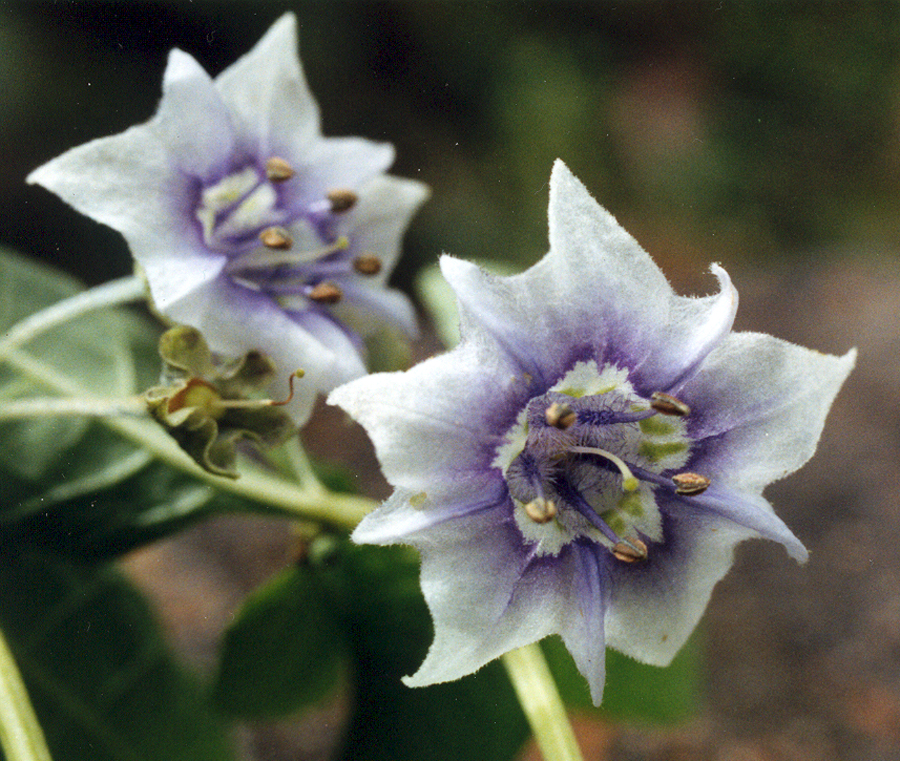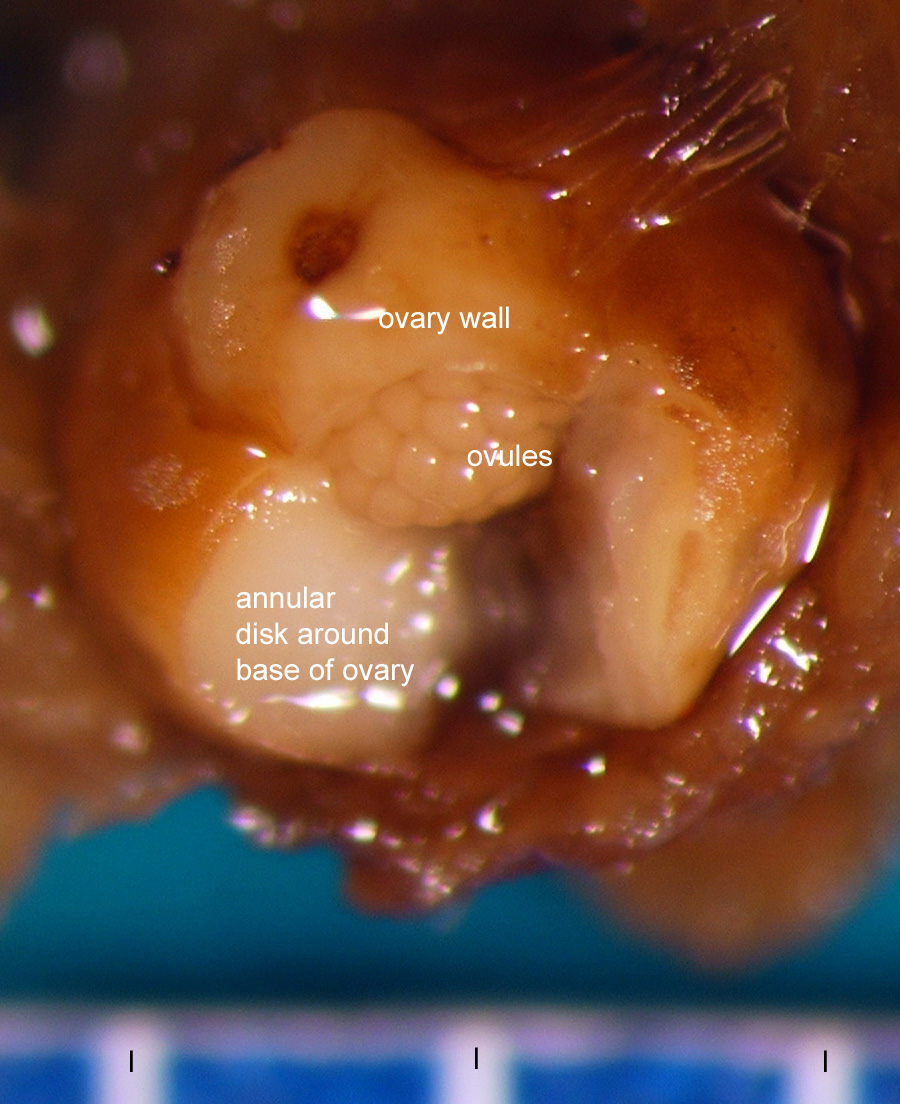Jaltomata mionei S. Leiva & Quipuscoa |
Peru |
revised Aug 2023 |
Link to Jaltomata homepage |
The information on this page may be cited as a communication with |
Link to Jaltomata of La Liberad, Peru |
Link to table comparing all Jaltomata species of northern Peru |
Link to edible Jaltomata species |
Link to local names of Jaltomata species |
| Figure 1. Anthers do not dehisce simultaneously (Mione et al. 817, photo by Thomas Mione) |
| Figure 2. Flower on right is older than the flower on the left (Mione et al. 817, photo by Thomas Mione) |
 |
Figure 3. Photo by |
| Character | Below: Description of Jaltomata mionei | Figures on this page |
Habit & Height |
Shrub (Leiva 558, 1797) but in protologue described as herbaceous |
|
Branches, young |
||
older |
||
Leaves, blade texture & size |
||
| blade shape including margin | ||
| hairs | ||
| petiole | ||
Inflorescence |
6 - 10 flowers (protologue) | |
peduncle & pedicel |
||
Calyx when flowering, color & size |
||
| shape / position during anthesis | ||
| hairs | ||
| at fruit maturity | ||
Corolla color |
||
| purple ring | yes | |
shape and size |
tubular | |
lobes / lobules |
10 total lobes plus lobules alternating | |
hairs
|
||
| no | ||
| no | ||
Stamen length including anther |
||
| length stamens exserted beyond distal end of corolla (applicable if corolla is tubular or campanulate) | ||
| position of stamens: a) before anthers dehisce, b) after anthers dehisce | ||
| base expanded laterally? | ||
| filaments | purple | |
| anther color | whitish | |
| anther size | ||
| anther mucronate/mucronulate | ||
| insertion of filament into anther | ||
| anthers of a flower open simultaneously? | no | Figure 1 |
| pollen quantity per flower | 119,000 | one flower of Mione 817 collected in Peru (not grown for study); count by Emmett P. Varricchio |
| pollen grain size | diameter (polar view): mean 28.65, range 27.5 - 30 micrometers |
n = 50 grains, stained in cotton blue in lactophenol,
anthers stored in 70% ethanol prior, Mione et al 537, flower collected in wild |
Gynoecium, stigma |
||
Style |
||
| Ovary & Ovarian Disk | ||
Ovules per ovary |
78 | one flower of Mione 817 collected in Peru (not grown for study); count by T. M. |
Nectar |
||
| Herkogamy | ||
| Protogyny | ||
Fruit color (at maturity) and size |
||
Seeds per fruit |
||
Seed Size |
||
Chromosome number |
||
Growability in Connecticut, USA |
||
How long does it take from flower to ripe fruit? |
||
Self-Compatible? |
||
Seed Germination |
||
Ratio of pollen to ovules |
1,526 (119,000 / 78 ovules) | one flower of Mione 817 collected in Peru (not grown for study) |
| Character | Above: Description of Jaltomata mionei | Figures on this web page |
| Locality | elev m |
habitat | date | collector | listed in protologue | Listed in Leiva's Master's Thesis (1998) | Data Entry |
|---|---|---|---|---|---|---|---|
| Abajo de San Andrés de Cárcel (camino al Salpo) | 2,560 | base de roca, tierra húmeda y rodeada de artubustos | 10 June 1992 | S. Leiva & P. Leiva 558 (HAO) | no | yes | May 2009 |
| Arriba de Piedra Gorda (ruta a Samne) | 2,600 | borde de carretera entre arbustos | 27 May 1993 | S. Leiva et al. 758 (HAO) | yes | yes | May 2009 |
| Abajo de Piedra Gorda (Ruta a Samne) | 2,550 | ladera | 27 May 1993 | S. Leiva G. et al. 762 (F, HAO) | yes | no | May 2009 |
| Abajo de Piedra Gorda (Ruta a Samne) | 2,550 | ladera | 27 May 1993 | S. Leiva G. et al. 763 (F, HAO) | yes | no | May 2009 |
| Abajo de Piedra Gorda (Ruta Salpo - Samne) | 2,700 | borde de camino | 16 June 1993 | S. Leiva G. 825 (HAO, US) | yes | yes | May 2009 |
| Abajo de Piedra Gorda (Ruta Salpo-Samne) | 2,680 | borde de camino | 13 Mar 1995 | S. Leiva G. 1691 (HAO) | no | yes | May 2009 |
| La Cuesta - El Choloque | 1,920 | ladera de arbustos | 18 Feb 1996 | S. Leiva & G. Salinas 1797 (F, HAO) | yes | no | May 2009 |
| ruta La Cuesta -Nambuque | 2,200 | borde de camino | 19 Feb 1996 | S. Leiva & P. Lezama 1806 (F, HAO) | yes | no | May 2009 |
| alrededores de Nambuque (arriba de La Cuesta) | 2,380 | borde de chacra | 19 Feb 1996 | S. Leiva & G. Salinas 1809 (HAO) | no | no | May 2009 |
| catarata Sanchique (Samne-Otuzco) | 2,900 | 29 May 1996 | S. Leiva & P. Lezama 1838 (herbarium specimen not seen by T. M.) | yes | no | Oct 2018 |
|
| desvio de Otuzco | 2,460 | borde de carretera | 17 May 1998 | S. Leiva G. & V. Quipuscoa S. 2187 (F, HAO, US) | no | no | May 2009 |
| In valley below the big waterfall above town of Yamobamba, 7.98 W, 78.51 S |
2,539 | near stream under trees | 18 Mar 1999 | D. M. Spooner et al. 7315b (NY, WIS) | not applicable because collected after | not applicable because collected after | May 2009 |
| Julcan. growing ca. 1 km NE of Canduall, 78.5 W, 8.1 S | 3,145 | in clay and sandy soil near pea field | 25 Mar 1999 | D. M. Spooner et al. 7332a (WIS) | not applicable because collected after | not applicable because collected after | Nov 2018 |
| entre Samne y Otuzco 7 56 17 S, 78 35 42 W | 2,340 | 11 Jun 1999 | Leiva, Mione & Yacher 2333; Mione, Leiva & Yacher 637 | not applicable because collected after | not applicable because collected after | Feb 2007 |
|
| parked at town of La Cuesta: 7 55 07 S, 78 42 22 W, and walked | 2,240 | Jun 1999 | Leiva, Mione & Yacher 2385; Mione, Leiva & Yacher 683 | not applicable because collected after | not applicable because collected after | Feb 2007 |
|
| quick stop when we were delayed by road contstruction; photos and DNA only, not pressed | not recorded | roadside (full sun) | 23 Mar 2013 | Mione, Leiva & Yacher 817 | not applicable because collected after | not applicable because collected after | May 2013 |
Flowering in Feb, March, May, June.
| Figure 4. An out-of-focus ovarian disk, orange, is at the bottom of this photo. One can see the ovarian disk after the corolla-androecium abscises (Mione et al. 817, photo by Thomas Mione) |
| Figure 5. The hairs (trichomes) of the filaments are unpigmented while the filament is pigmented purple. The stigma is green while the style to which it is attached is whitish (Mione et al. 817, photo by Thomas Mione) |
| Figure 6. The stigma is green and located centrally between the dehisced anthers (Mione et al. 817, photo by Thomas Mione) |
 |
Figure 6. Jaltomata mionei
Ovary dissected open to show annual disk around base of ovary and ovules. On the (out of focus) metric ruler at base it is 1 mm from vertical black line to vertical black line. Flower had been stored in 70% ethanol for months prior to dissection.
Mione et al. 817 |